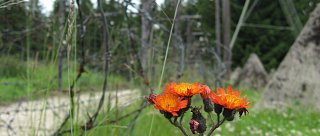Bučina
Discover the Šumava replica of the Iron Curtain.
The former highest-altitude Šumava settlement was founded in the second half of the 18th century.
In 1911, 347 people lived here in 37 houses, of which eight declared Czech as their main language. A prominent building in Bučina was a large customs house, which was designed to serve as a fortress in the event of an attack. After World War II, the village ceased to exist. In 1956, all buildings were demolished except for the so-called Pešl's Hut, which was retained for the needs of the border guard. Its ruins were removed in 2003, when the decision was made to build a new hut. Bučina is one of the rainiest places in Šumava, with around 1,600 mm of precipitation annually. The village was the birthplace of Johann Peter, a notable regional poet and writer. According to old guidebooks, Bučina offers the most beautiful view of the Alps from the Šumava mountains. The educational trail "National Park," 6.5 km long with 8 information panels, begins and ends here. It documents how humans shaped the landscape that today belongs to the national park.
Accessibility and distances:
Marked hiking trails lead to Bučina from Kvilda (total loop approx. 18 km) and Borová Lada (also approx. 18 km). A trip to Bučina can be combined with a visit to the Vltava springs or the abandoned village of Knížecí Pláně.



